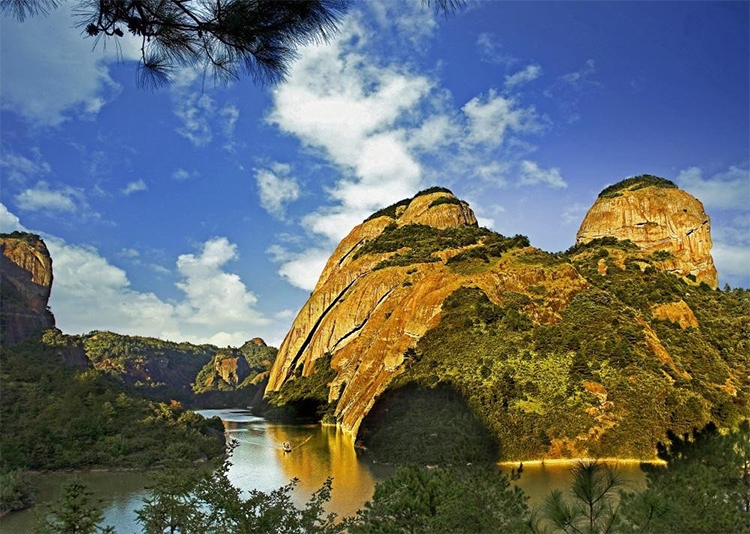Jiangxi Travel: Explore Hanxian Rock, Danxia Wonders and Taoist Trails
Introduction:
Nestled in the green hills and clear rivers of southern Jiangxi, Hanxian Rock (汉仙岩) rises in striking oxblood-red cliffs and pinnacles. Revered locally as “Qiannan’s First Mountain,” the site is steeped in legend — one tale says the immortal Han Zhongli attained enlightenment here — blending spectacular Danxia landforms with a mysterious Taoist atmosphere. Walk the peaks and caves carved by deep time, follow the footsteps of ancient scholars, and feel a timeless harmony between nature and culture.
1. World-class Danxia landscape and Taoist sanctuary
Hanxian Rock is a classic Danxia landform covering about 40 square kilometers, formed during the Cretaceous period between 140 million and 65 million years ago. Its vivid red sandstones — described as “as red as cinnabar, bright as dawn” — have been sculpted over eons by water and wind into dramatic ridge forests, cliffs, pillars, and natural stone bridges. The park preserves more than 30 cliff inscriptions, some dating back to the Song dynasty. The most famous is the Ming‑era Neo‑Confucian Wang Yangming’s inscription “天子万年” (Tianzi Wannian), evidence of the area’s deep cultural legacy that complements its geological fame.
2. A changing natural canvas through the seasons
Hanxian Rock rewards visitors year-round. Spring (March–May) fills the hills with blooming rhododendrons contrasting against red rock; summer (June–August) offers cool, shaded trails; autumn (September–November) brings crisp skies and colorful foliage; winter (December–February) cloaks the peaks in mist for an otherworldly scene. The best times to visit are spring and autumn when temperatures are comfortable and visibility is high—ideal for photography and hiking. After rain, the valley often fills with a sea of clouds, making the Danxia pinnacles appear to float like islands in the mist.
3. Diverse experiences for every traveler
Beyond sightseeing, Hanxian Rock offers varied activities. Photographers chase sunrise and sunset light across the red cliffs. Hikers can choose routes ranging from a relaxed 1‑hour loop to full‑day ascents of the main peak. Culture enthusiasts can explore cliff‑carved inscriptions and ancient temple remains, where Confucian, Buddhist, and Taoist influences meet. The headwaters of the Xiang River flow clear and cold — a refreshing spot to cool off in summer.

4. Largely pristine ecology
Over 80% forest cover preserves a near‑pristine ecology; high concentrations of negative oxygen ions make the area a natural “oxygen bar.” Rare plants grow in shaded gullies, and small mammals like squirrels and hares are often seen darting through the woods. Clean, unpolluted streams and intact habitats make Hanxian Rock an excellent destination for nature lovers.
5. Easy access and travel times
Hanxian Rock sits in Junmenling Town, Huichang County, Ganzhou City, Jiangxi Province. It is about 120 km (roughly 2 hours by car) from Ganzhou Huangjin Airport and about 100 km (1.5 hours) from Ganzhou West High‑Speed Rail Station. Self‑drive or private car/charter are recommended to enjoy scenic countryside en route. Regular shuttle buses run from Huichang County to the park (approx. 40 minutes). A spacious parking lot is available for visitors driving in.
6. Practical touring tips
Plan 4–6 hours to see highlights. A recommended route: Entrance → Main Peak of Hanxian Rock → “Tianzi Wannian” stone inscription → Xiang River source → Lion Rock → Exit. Fit hikers can climb the main peak for panoramic views; those with children or older travelers can choose gentler trails with rest areas and observation platforms. Entering before 8:00 AM helps avoid crowds and captures soft morning light.

7. Comfortable visiting environment
Peak travel times are during May Day, National Day, and summer holidays—consider visiting off‑peak on weekdays for a quieter experience. The park caps daily visitor numbers (maximum around 5,000) to preserve quality and avoid overcrowding.
8. Multilingual services for foreign visitors
Hanxian Rock provides Chinese and English maps and signs, and key sites include English explanations. English guided tours can be reserved with at least one day’s notice. Audio guides are available for rent at the entrance and support Chinese, English, Japanese, and Korean.
9. Ticketing and pricing
Admission: Peak season (April–October) RMB 80; Off‑season (November–March) RMB 60. Discounts apply for students, seniors, and military. Tickets cover all natural and cultural attractions within the park; the internal shuttle bus costs an additional RMB 20 per person. Purchasing tickets in advance via the official WeChat account may qualify for a 10% discount.

10. Local food and accommodation
Entrance restaurants serve Jiangxi specialties such as Huichang rice noodles, southern Jiangxi stir‑fried fish, and Hakka stuffed tofu. Junmenling Town has guesthouses and small hotels with prices typically ranging from RMB 100–300 per night. Try local Hakka dishes for an authentic taste of southern Jiangxi.
11. Opening hours and entry requirements
Hours: Peak season 07:30–18:00; Off‑season 08:00–17:30. No advance reservation is needed most days, but early arrival is recommended for holidays. The park uses real‑name ticketing—please bring valid identification.
Conclusion:
Hanxian Rock is more than a geological spectacle; it is a living cultural museum where red cliffs, ancient inscriptions, Taoist legends, and lush forests come together. Whether you seek dramatic landscapes, cultural depth, or a peaceful escape from city life, Hanxian Rock delivers an unforgettable Jiangxi experience. Pack your camera, lace up your hiking shoes, and discover your own tranquil spot among the red rocks and green waters.


